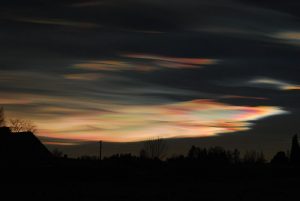Polar stratospheric clouds
These opalescent clouds appearing during winter at high latitudes, in the lower stratosphere, at altitudes between about 15 to 25 km (normally, stratosphere is cloud-free due to its extreme dryness). They are only found in the polar regions, where stratospheric temperatures fall below about -700C, cold enough to initiate their formation.
Called “Mother of Pearl” by Scandinavians due to their iridescent,colourful appearance, these clouds are composed of mixtures of naturally occurring water and nitric acid.
Their surfaces act as catalysts which convert more benign forms of man-made chlorine into active free radicals (for example ClO, chlorine monoxide). During the return of Spring sunlight these radicals destroy many ozone molecules in a series of chain reactions. Also, they remove nitrogen compounds that moderate the destructive impact of chlorine.
Scientists recently discovered that polar stratospheric clouds, long known to play an important role in Antarctic ozone destruction, are occurring with increasing frequency in the Arctic. In recent years, the atmosphere above the Arctic has been colder than usual, and polar stratospheric clouds have lasted into the spring. As a result, ozone levels have been decreasing.
Photo: Lake Mjosa, Norway, Wikimedia commons, author: Honzach.



 This project (EDU-ARCTIC) has received funding from the European Union’s Horizon 2020 research and innovation programme under grant agreement No 710240. The content of the website is the sole responsibility of the Consortium and it does not represent the opinion of the European Commission, and the Commission is not responsible for any use that might be made of information contained.
This project (EDU-ARCTIC) has received funding from the European Union’s Horizon 2020 research and innovation programme under grant agreement No 710240. The content of the website is the sole responsibility of the Consortium and it does not represent the opinion of the European Commission, and the Commission is not responsible for any use that might be made of information contained.